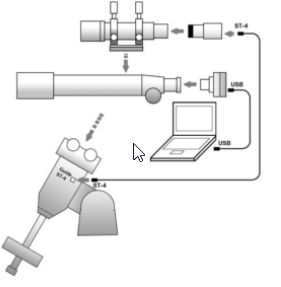Glossary |
Auto-Guiding with ST-4 |
updated: 2024-03-19 |
If you are planning to capture longer exposures with your DSLM of CMOS camera you will need some kind of autoguider that keeps your target and automatically corrects small pointing errors deriving (e.g. periodic errors) from your equipment or atmospheric turbulences.
Autoguiding typically requires an additional camera fixed to your guider scope. This camera will lock on a star and with help of some electronics (like ASIAIR Pro) or a computer program (like ) will constantly calculate tracking correction steps that it sends to your mount (via an ST-4 interface) to compensate for the error.
- Connect the ST-4 port of the guide camera with the ST-4 port of the mount.
- Connect the USB port at the camera with a computer, select a guide star and let the mount do the guiding.
- On select "On-Camera" as mount
- on ASIAIR Pro select "On-Camera-ST4" as mount
Disadvantages of ST-4 Guiding
- With ST-4 you have to calibrate near your target. The pole area is not a good/easy place to calibrate.
- Using ST-4 for you need to re-calibrate on each target as ST-4 cannot transmit the current declination from the mount to or which side of the pier it is on (as compared to the ASCOM protocol). ASCOM lets re-use a calibration rather than having to re-calibrate on each target, and to adjust automatically after a meridian flip.
- No GoTo function will be provided by any tools, you'll have to use the hand controller of your mount to move the telescope into the right direction
- No Dithering
- The ST-4 is only intended for guiding, nothing else will be available
Autoguider Configurations (pictures by courtesy of Astroshop)
|
Configuration |
Specifics |
Schema |
Pro's and Con's |
|
Computer based guiding |
Using a guide scope |
|
|
|
Using a Off-Axis-Guider |
|
|
|
|
Stand-Alone Guide |
Using a guide scope |
|
|
|
Using a Off-Axis-Guider |
|
best suited for Maksutov or Schmidt-Cassegrain telescopes:
|
Here are links to some good articles about autoguiding:
- on the Astroshop website (only in German)
- from Astrobackyard
- from SkyAtNight
- from AstroGear
Created with the Personal Edition of HelpNDoc: Make Your PDFs More Secure with Encryption and Password Protection




